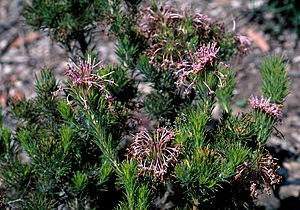Spider coneflower facts for kids
Quick facts for kids Spider coneflower |
|
|---|---|
 |
|
| Scientific classification | |
| Genus: |
Isopogon
|
| Species: |
adenanthoides
|
 |
|
| Occurrence data from Australasian Virtual Herbarium | |
| Synonyms | |
|
Atylus adenanthoides (Meisn.) Kuntze |
|
The spider coneflower (its scientific name is Isopogon adenanthoides) is a special plant. It belongs to a plant family called Proteaceae. You can only find it naturally in the southwest part of Western Australia. This plant is a straight-growing bush with pointy leaves. Its flowers are pink and grow in round clusters.
Contents
What Does the Spider Coneflower Look Like?
The spider coneflower is a bush that stands upright. It usually grows to be about 1 meter (or 3 feet) tall and wide. Its small branches are often hairy and can be grey or brownish.
The leaves of this plant are quite unique. They are "trifid," which means they split into three parts at the end. Each part has a sharp, pointed tip. These leaves are about 10 to 18 millimeters long and less than 1 millimeter wide. They grow on a small stalk called a petiole, which is about 2 to 8 millimeters long.
The flowers of the spider coneflower are pink and grow in round clusters. These clusters are about 40 to 45 millimeters across. Each cluster can have up to 25 smooth, pink flowers. At the bottom of each flower cluster, there are hairy, egg-shaped leaves called bracts.
This plant usually blooms, or flowers, from July to October. After the flowers, it produces a hairy, nut-like fruit. These small fruits are about 4 millimeters long and are joined together in a round head, about 15 millimeters wide.
How Did It Get Its Name?
The spider coneflower got its scientific name, Isopogon adenanthoides, a long time ago. A scientist named Carl Meissner first officially described it in 1855. He wrote about it in a science journal called Hooker's Journal of Botany and Kew Garden Miscellany. The plants he studied were collected by another botanist named James Drummond.
Where Does the Spider Coneflower Grow?
The spider coneflower lives in areas with lots of bushes and open heathland. You can find it in the southwest part of Western Australia. Its natural home stretches from places like Eneabba and Badgingarra down to near Moora.
Is the Spider Coneflower Safe?
Good news! The Western Australian Government's Department of Parks and Wildlife has looked at the spider coneflower. They have decided that it is "not threatened." This means there are enough of these plants in the wild, and they are not currently in danger of disappearing.

